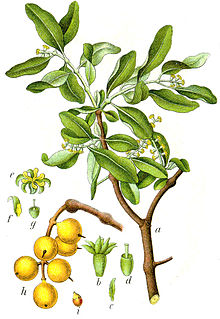Loranthus
| Loranthus | |
|---|---|

| |
| Loranthus europaeus | |
| Scientific classification | |
| Kingdom: | Plantae |
| Clade: | Tracheophytes |
| Clade: | Angiosperms |
| Clade: | Eudicots |
| Order: | Santalales |
| Family: | Loranthaceae |
| Genus: | Loranthus Jacq., nom. cons.[1] |
Loranthus is a genus of parasitic plants that grow on the branches of woody trees. It belongs to the family Loranthaceae, the showy mistletoe family.[2] In most earlier systematic treatments it contains all mistletoe species with bisexual flowers, though some species have reversed to unisexual flowers. Other treatments restrict the genus to a few species. The systematic situation of Loranthus is not entirely clear.
Taxonomy
The taxonomic history of the generic name Loranthus is complicated. In 1753, Carl Linnaeus used the name Loranthus for a genus of one species, Loranthus americanus, which was thus the type species. He later added other species, including Loranthus scurrula in 1762, a species he had previously placed in a separate genus, Scurrula, and Loranthus europaeus in 1763, a name first used by Jacquin in 1762. However, Loranthus americanus has been included in Psittacanthus since that genus was first erected in 1830. Application of priority as set out in the International Code of Nomenclature for algae, fungi, and plants requires the name Loranthus to be used instead of Psittacanthus, with a different genus name used for the remaining species Linnaeus placed in Loranthus. To avoid altering established usage, the International Botanical Congress of 1930 decided to conserve Loranthus L. (1762), with the type species Loranthus scurrula, over Loranthus L. (1753). However, when Loranthus in this sense was split further, Loranthus scurrula was placed in the revived genus Scurrula. The conservation decision in 1930 meant that Loranthus should be used instead of Scurrula, and a different name used for Scurrula.[3] Again to avoid altering established usage, a proposal was agreed in 1964 to conserve Loranthus Jacq. (1762), with the type species Loranthus europaeus, over Loranthus L. (1753).[4]
Species
The number of species recognized in the genus Loranthus has varied widely. At one time it included almost all mistletoes. It was then split into many genera, leaving only L. europaeus from Europe eastwards and L. odoratus from tropical Asia.[5] The Flora of China lists six species native to China (three endemic), stating that there are about ten species in total.[6] Species recognized as of May 2015[update] are:[5][6][7]
- Loranthus delavayi Tiegh.
- Loranthus europaeus Jacq.
- Loranthus guizhouensis H.X.Qiu
- Loranthus kaoi (J.M. Chao) H.S.Kiu
- Loranthus lambertianus Schult.f.
- Loranthus longiflorus Desr.
- Loranthus macrantherus (Eichler) Hemsl.
- Loranthus pseudo-odoratus Lingelsh.
- Loranthus pulverulentus Wall.
- Loranthus tanakae Franch. & Sav.
Ecology
Some species of Loranthus, in the broad sense, are parasites on cultivated trees; for example, they occur in Kerala and Uttarakhand India on mango trees (Mangifera indica), sapota trees (Manilkara zapota) and poplar trees.[8] The majority of the Anogeissus latifolia trees in the Biligirirangan Hills of Karnataka are infected by Loranthus species and in Africa, they are pests in cocoa plantations. These plants grow strongly on ageing trees particularly somewhere in the middle of old branches. Once established, they steal minerals and water, as well as block sunlight by covering the encroached place.[8]
The flowers of Loranthus europaeus are small, green, usually have four to six parts, and may be either unisexual or bisexual. Other species of a broader Loranthus have very large, showy flowers, with blooms in bright colours. The fruits are berries, usually containing a single seed, that is dispersed by birds.[citation needed]

The floral characteristics indicate that it is ornithophilous in nature and has moderate quantity nectar stored in its perianth tube. The mature buds require external factors like tripping to ensure that they open up. In the absence of this, the buds fall off without opening. Birds help in this process and mature buds eject a cloud of pollens that sticks to the head or beak of the probing bird. The birds seen visiting these flowers in India are Tickell's flowerpecker, purple-rumped sunbird, purple sunbird and spider-hunter.[9][10]
References
- ^ "Plant Name Details for Loranthus Jacq". The International Plant Names Index. Retrieved 2017-05-02.
- ^ Watson, L., and Dallwitz, M.J. 1992 onwards. The families of flowering plants: descriptions, illustrations, identification, and information retrieval. Loranthus
- ^ Balle, Simone; Dandy, J.E.; Gilmour, J.S.L.; Holttum, R.E.; Stearn, W.T. & Thoday, D. (1960). "Loranthus". Taxon. 9 (7): 208–210. doi:10.2307/1216271. JSTOR 1216271.
- ^ Rickett, H.W. (1964), "Committee for Spermatophyta, Conservation of Generic Names VI", Taxon, 13 (5): 180–182, doi:10.2307/1216139, JSTOR 1216139
- ^ a b Nickrent, Daniel L.; Malécot, Valéry; Vidal-Russell, Romina & Der, Joshua P. (2010). "A revised classification of Santalales" (PDF). Taxon. 59 (2): 538–558. doi:10.1002/tax.592019. Retrieved 2017-05-02.
- ^ a b Qiu, Huaxing & Gilbert, Michael G. "Loranthus". In Wu, Zhengyi; Raven, Peter H. & Hong, Deyuan (eds.). Flora of China (online). eFloras.org. Retrieved 2017-05-02.
- ^ "Search results for Loranthus". The Plant List. Retrieved 2017-05-02.
- ^ a b Kumari, S., Singh, A.K., Kumar, S., and Shah, V.K. (2020). A Hidden Problem: Loranthus falcatus L. & Loranthus parasitica L. for Horticulture Crops. Agriculture and food eNewsletter, 2(5):719-721. https://www.researchgate.net/publication/341182673_A_Hidden_Problem_Loranthus_Falcatus_L_Loranthus_Parasitica_L_for_Horticulture_Crops
- ^ Solomon, Raju; et al. (2003). "Passerine_bird_pollination_in_some_dry_season_blooming_plant_species_in_the_Eastern_Ghats". ResearchGate. 7 (4): 286.
- ^ Devasahayam S & Rema J (1993). "Flower birds of Kozhikode District, Kerala". Newsletter for Birdwatchers. 33 (6): 103–105.
